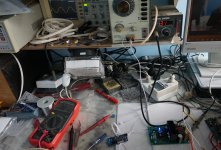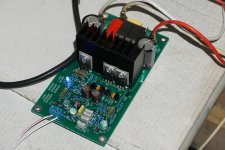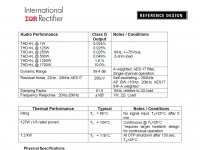First, I would like to give this one to find a space for discussion.
I first thought of here.
It is the same as the structure of many friends here.
Maybe I didn't do the best.
+ -75V DC
I have been used for a few days in a row, it sounds very good, from the test also and I expect the same.
Although it is still a little hot, I replaced many capacitance, testing,
I hope that any I design an amplifier can steadily work for many years.
In the case of more than 300 w power 4 ohms, can stable operation.
Temperature basically control within 50 degrees, but I think maybe a fan, will be cooler.
I first thought of here.
It is the same as the structure of many friends here.
Maybe I didn't do the best.
+ -75V DC
I have been used for a few days in a row, it sounds very good, from the test also and I expect the same.
Although it is still a little hot, I replaced many capacitance, testing,
I hope that any I design an amplifier can steadily work for many years.
In the case of more than 300 w power 4 ohms, can stable operation.
Temperature basically control within 50 degrees, but I think maybe a fan, will be cooler.
Attachments
On circuit data, I refer to the IRAUDAMP9.
I didn't make any other changes.
It basically has no noise,
The sound of music is good, although I prefer the analog amplifier.
But this digital amplifier can load a low impedance, and get a relatively large power.
Perhaps for some professional speakers.
I use a large shielded inductor, 7G23A. it has a relatively high current, and a very low resistance.
Also I want to say, I still don't like the SMD resistor. I think its reliability is not ideal.
I didn't make any other changes.
It basically has no noise,
The sound of music is good, although I prefer the analog amplifier.
But this digital amplifier can load a low impedance, and get a relatively large power.
Perhaps for some professional speakers.
I use a large shielded inductor, 7G23A. it has a relatively high current, and a very low resistance.
Also I want to say, I still don't like the SMD resistor. I think its reliability is not ideal.
All of its components are very hot. This is my first impressions.
Resistor, capacitor, transistor, inductance. Everything is very hot.
So the stability of long time work load test, it is very important.
When indoor temperature of 23 degrees Celsius. Many components are more than 50 degrees Celsius.
Luckily, they did not continue to increase. I will be tested for a long period of time.
Resistor, capacitor, transistor, inductance. Everything is very hot.
So the stability of long time work load test, it is very important.
When indoor temperature of 23 degrees Celsius. Many components are more than 50 degrees Celsius.
Luckily, they did not continue to increase. I will be tested for a long period of time.
I suspect some of the components are getting hot by conduction from other components.
Capacitors shouldn't get hot if operated inside the correct parameters.
If the heat sink is hot then maybe you are getting some cross conduction.
Try increasing dead time.
I used a t106-2 core and mine barely gets warm.
Capacitors shouldn't get hot if operated inside the correct parameters.
If the heat sink is hot then maybe you are getting some cross conduction.
Try increasing dead time.
I used a t106-2 core and mine barely gets warm.
I suspect some of the components are getting hot by conduction from other components.
Capacitors shouldn't get hot if operated inside the correct parameters.
If the heat sink is hot then maybe you are getting some cross conduction.
Try increasing dead time.
I used a t106-2 core and mine barely gets warm.
Are you sure you're making IRAUDAMP9?
+ - 75 v dc voltage, and use IRFB4227?
I see the IRAUDAMP9 document.
The temperature inside the report data is as follows
125W about 104 c
I use for a long time for testing.I for improved capacitor model.
All components including inductors, the temperature is below 65 degrees Celsius.
I think it is the ideal state.
I don't use the T106-2 inductance.
Because I tried a long time ago.
Attachments
Last edited:
D
Deleted member 148505
What totem pole buffers did you use?
Increase gate resistors to 12 ohms to decrease heating of buffer and output mosfets, increase oscillating frequency to 400khz to decrease heating of inductor. Use DIP16 version of IRS2092 so that you can increase the operating frequency without overheating problems,. Also there are many IRS2092S SMD counterfeit ICs.
Do not feed frequencies to input greater than 20khz as said in the application note to prevent output filter resonance. (make sure there's no unwanted oscillation on preamp's output)
Your heatsink is only good for dissipating voltage regulator heat, cooling fan is recommended.
IRAUDAMP9 main schematic is same as IRAUDAMP7, just added totempole buffers, HOPS and increased deadtime.
I can't detect drastic change in sound when using IRFB4227 vs default iraudamp7 mosfets. Still as good as IRAUDAMP7. Though on THD measurements it should be worse because of increased deadtime setting.
Increase gate resistors to 12 ohms to decrease heating of buffer and output mosfets, increase oscillating frequency to 400khz to decrease heating of inductor. Use DIP16 version of IRS2092 so that you can increase the operating frequency without overheating problems,. Also there are many IRS2092S SMD counterfeit ICs.
Do not feed frequencies to input greater than 20khz as said in the application note to prevent output filter resonance. (make sure there's no unwanted oscillation on preamp's output)
Your heatsink is only good for dissipating voltage regulator heat, cooling fan is recommended.
IRAUDAMP9 main schematic is same as IRAUDAMP7, just added totempole buffers, HOPS and increased deadtime.
I can't detect drastic change in sound when using IRFB4227 vs default iraudamp7 mosfets. Still as good as IRAUDAMP7. Though on THD measurements it should be worse because of increased deadtime setting.
Did you find why it was running hot? how is it sounding now
Greg
L30D is lower than IRAUDAMP9 temperature.
So it's normal work.
Sound very good. Especially the state of high power.
What totem pole buffers did you use?
Increase gate resistors to 12 ohms to decrease heating of buffer and output mosfets, increase oscillating frequency to 400khz to decrease heating of inductor. Use DIP16 version of IRS2092 so that you can increase the operating frequency without overheating problems,. Also there are many IRS2092S SMD counterfeit ICs.
Do not feed frequencies to input greater than 20khz as said in the application note to prevent output filter resonance. (make sure there's no unwanted oscillation on preamp's output)
Your heatsink is only good for dissipating voltage regulator heat, cooling fan is recommended.
IRAUDAMP9 main schematic is same as IRAUDAMP7, just added totempole buffers, HOPS and increased deadtime.
I can't detect drastic change in sound when using IRFB4227 vs default iraudamp7 mosfets. Still as good as IRAUDAMP7. Though on THD measurements it should be worse because of increased deadtime setting.
Temperature difference. Is mainly caused by voltage.
IRAUDAMP9 hypothesis radiator, under the condition of same temperature is higher. This is normal.
In IRAUDAMP9 PDF document showing temperature under normal circumstances, greater than 104 degrees Celsius.
While L30D essentially no more than 70 degrees.
And work measurement is stable for a long time.
So I think there is no problem currently L30D.
Relative to IRAUDAMP7S, its biggest change is that can drive a low impedance load.
And very stable, there will not be protected. Voice closed questions.
And it's really great power.
IRAUDAMP7S nominal power I think is not actual speakers can achieve in the test.
Its power can only one-third of the PDF document's data.
Because when the speaker load, it's big
Hi Ljm, do you have a schematic for the l30d as i have bought 2 boards and they are not working well. frequency is around 200khz and loud audible oscillation on output. music is distorted and when turning volume up it cycles on and off about every 2seconds i have a scope and would love to to get them working properly. Greg
i looked L30D up on aliexpress and found this:
L30D/300 850W Single Channel Digital Finished Amplifier Board IRS2092 IRFB4227 IRAUDAMP9-in Amplifier from Consumer Electronics on Aliexpress.com | Alibaba Group
is TZT an authorized seller?
the description says Vmin is +-60V.
how bad would +-50V be?
L30D/300 850W Single Channel Digital Finished Amplifier Board IRS2092 IRFB4227 IRAUDAMP9-in Amplifier from Consumer Electronics on Aliexpress.com | Alibaba Group
is TZT an authorized seller?
the description says Vmin is +-60V.
how bad would +-50V be?
Hi Ljm, do you have a schematic for the l30d as i have bought 2 boards and they are not working well. frequency is around 200khz and loud audible oscillation on output. music is distorted and when turning volume up it cycles on and off about every 2seconds i have a scope and would love to to get them working properly. Greg
You can rest assured.
Each piece of L30D is through my careful testing can determine 100% no problem.
L30D only need to meet the voltage to meet the requirements on it. 70V + +, or about 75V.
Low voltage will not work.
i looked L30D up on aliexpress and found this:
L30D/300 850W Single Channel Digital Finished Amplifier Board IRS2092 IRFB4227 IRAUDAMP9-in Amplifier from Consumer Electronics on Aliexpress.com | Alibaba Group
is TZT an authorized seller?
the description says Vmin is +-60V.
how bad would +-50V be?
Below + -60 v will not work.
Recommended voltage + - 75 v.
It is very stable,
http://www.diyaudio.com/forums/class-d/284655-iraud200-short-story.html this board is similar and I scrapped with it a long time until it behaved. There may be some helpful info. there.
Thank you mgshightech. this board is very unstable, i have had to adjust the feedback and the input is very sensitive to noise. Greg
L30D Very stable.
Using the + - 75 - v voltage.
And his voice is also very stable. Because I use it for a long time.
We don't need to study its design principle. Because a lot of people don't understand.
We simply know. It is very stable. Power is likely to be the largest in the digital power amplifier now.
And is actually to be able to use good voice. A lot of digital power amplifier, is only the theoretical value of outstanding.
Is not actually used. L30D is very good in actual use.
We only need to use the power is connected, do not need to be further study of it.
http://www.diyaudio.com/forums/class-d/284655-iraud200-short-story.html this board is similar and I scrapped with it a long time until it behaved. There may be some helpful info. there.
I don't want to comment on this product. I just want to say, free send to me, I also don't want. Really.
ljm,
Is LD30 listed on your TB shop?
https://item.taobao.com/item.htm?spm=686.1000925.0.0.Vb08km&id=522731518819
- Home
- Amplifiers
- Class D
- L30D IRS2092 IRFB 4227 IRAUDAMP9 MYDIY


